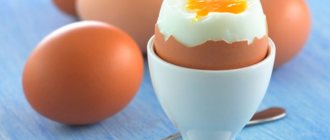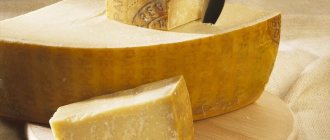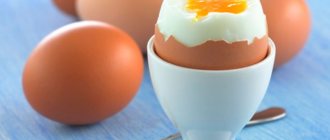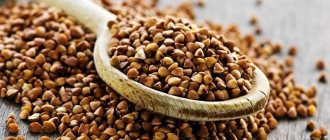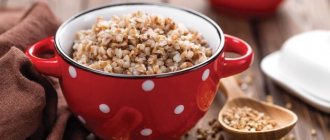Using buckwheat for weight loss and dietary purposes
Using buckwheat for weight loss is a fairly simple and common method.
There are many variations of specially designed diets for overweight people. Each person individually selects the most suitable method of consuming buckwheat for weight loss. The effectiveness of weight loss is achieved due to the low calorie content and nutritional properties of this product. In addition, eating buckwheat cleanses you of waste and toxins, which is also of great importance for weight loss.
The benefits that need to be highlighted from eating buckwheat for weight loss:
- Lack of hunger for a long time
- By consuming this type of porridge, it is possible to cope with cellulite. Buckwheat porridge contains microelements that effectively fight subcutaneous fat
- Improved skin and hair condition
- Fast weight loss
However, among the large number of benefits, there are some contraindications for using buckwheat for weight loss.
- Nutritionists do not recommend using the buckwheat diet for people who suffer from chronic stomach diseases.
- Also in the presence of low blood pressure and low hemoglobin levels.
- It is strictly forbidden to follow dietary nutrition for nursing women and during the period of bearing a child.
Before following a dietary regimen using buckwheat, you should consult your doctor to prevent unpleasant situations.
Buckwheat diet
The buckwheat diet can be of various types, which differ not only in the method of preparation, but also in the intensity of use. Nutritionists recommend using gentle types of diets for the first time when using buckwheat diets, and then gradually move on to more intense ones.
When following a diet, you must adhere to certain features:
- Buckwheat porridge should be consumed without adding salt or oil.
- It is allowed to eat porridge with fruit or dairy products
- You should not suddenly replace all products with buckwheat porridge; you need to gradually reduce the amount, while the volume of fruit consumption remains unchanged.
- You should not follow an intensive diet for more than 10 days; you need to take breaks.
- You need to drink plenty of fluids
- Nutritionists recommend taking a vitamin complex at the same time.
- It is necessary to end the diet gradually. This will help prevent a sudden return of the disappeared kilograms.
The buckwheat diet is as follows:
- Buckwheat should be present in almost every dish
- When following a diet, avoid eating sugar and other spices.
- It is recommended to eat low-fat kefir after eating buckwheat.
Sample daily menu for a buckwheat diet:
- breakfast – buckwheat porridge with dried apricots, green tea
- lunch – buckwheat soup with vegetable broth, a glass of low-fat kefir
- afternoon snack – raw vegetables, fruits
- dinner - buckwheat porridge with water, fresh cabbage salad with olive oil, kefir.
When following a diet, you need to choose a product with a kernel mark; you need to prepare porridge in a volume that is designed for consumption for one day.
How to cook buckwheat correctly
The effectiveness of the buckwheat diet depends on proper preparation of the grain. There are several ways to steam buckwheat for your diet:
- fill with cold water;
- steam with boiling water;
- soak in kefir;
- steam in a thermos.
Soaked or steamed buckwheat can be used in various recipes. Buckwheat cutlets, pancakes, muffins, breads and casseroles are allowed during long-term diets. When preparing them, you just need to remember the total calorie content and avoid adding butter, large amounts of eggs, wheat flour and sugar. It is better to replace wheat flour with whole grain or oatmeal, and use honey or fruit as a sweetener.
Soaking with cold water
Buckwheat is rarely soaked in water at room temperature. The method is unpopular because the cereal turns out to be harsh and lacking in taste. Not everyone likes this porridge. Buckwheat should be soaked in cold water for at least 12-16 hours. First, the cereal must be thoroughly washed and sorted.
Steaming with boiling water
How to steam buckwheat for weight loss:
- rinse and sort out a glass of buckwheat;
- pour 2 cups boiling water over buckwheat;
- Close the container with a lid and wrap it in a warm blanket or towel.
The porridge will be ready to eat in 7-9 hours. Green cereals, kernels, and even buckwheat are suitable for steaming. It is not advisable to salt the cereal, but you can add a tsp to the finished porridge for taste (if diet conditions allow). honey or syrup, pieces of fruit, low-fat yogurt or nuts.
Soaking in kefir
For breakfast, it is better to eat buckwheat soaked in kefir. This dish will not only give you a feeling of fullness for a long time, but also:
- improves the functioning of internal organs;
- will reduce the risk of developing putrefactive processes in the intestines;
- will replenish the water-salt balance;
- normalizes intestinal microflora;
- will increase emotional stamina and concentration;
- improves the functioning of the central nervous system.
To prepare you need to take 1 tbsp. l. kernels or green buckwheat and 100 ml of 1% kefir. The buckwheat is washed, sorted and poured with kefir. Place in the refrigerator for 10-12 hours.
Buckwheat soaked in kefir can be consumed not only during a diet. On ordinary days, it is recommended to eat it 30-40 minutes before breakfast to improve stomach function, cleanse the body and strengthen the immune system. For taste, dried fruits, flax seeds or sesame seeds, berries or fruits are added to the porridge. After buckwheat-kefir porridge, nutritionists recommend drinking a glass of green tea without sugar.
Steaming in a thermos
Buckwheat porridge is often prepared in a thermos. The advantage of this method is its simplicity: the steaming time is reduced to 3-4 hours, the disadvantage is that it is not always convenient to remove swollen buckwheat grains from the neck of the thermos.
To steam, buckwheat is washed and sorted, poured into a thermos and poured boiling water. For 1 cup of kernels or green cereal, take 2 cups of hot water. Salt is prohibited. Before eating, you can pour 2-3 tbsp into the porridge. kefir If diet conditions allow, then season the steamed buckwheat with tsp. honey, nuts, sesame or flax seeds, dried fruits.
Reviews from those who have lost weight
Losing weight on buckwheat and kefir is a popular diet. On the Internet you can find videos with reviews and comments from those who have tried this method of losing excess weight.
Alena K.: “After giving birth to a child, I can’t lose weight. A friend highly recommended buckwheat with kefir, and only with it did she get back into shape. I’ve been doing fasting days for a month now, one a week, it turns out well, it’s not annoying, because it’s invisible to the family, and it’s not difficult for me. On this day, everyone eats buckwheat for lunch, and I eat it all day. My stomach has noticeably gained weight, my arms have lost weight, and my legs have lost some weight. I will continue.
Nelly Zh.: “I tried several diets, I only liked the Kremlin one. Now I’m mastering buckwheat. I tried it for 3 days, it wasn’t easy. It's hard to eat buckwheat with kefir when everyone around you eats other foods. I could hardly stand it, but I lost 2800 g! This inspired me. Now the family is leaving for the weekend for 3 days, I will repeat the diet, I hope it will work out.”
Valera P: “I have to lose weight, of all the diets I chose buckwheat with kefir. I started with 3 days, now I last 7 days. It’s difficult that you have to eat often, because you have to be at home all the time or take it with you. It’s inconvenient to constantly remember at work that you need to eat. I kill the feeling of hunger with chewing gum. I previously lost 2 kg, but then gained it back again.”
Lesha D: “This diet is good because it is based on natural products. I chose fasting days because they have a lighter menu, and I go in for sports, because this is also useful, all together it gives me a good figure. I don’t know what helped, but I feel great. I think it's all together. The intestines work according to the clock. I recommend this diet to everyone to forget about pills.
What are the advantages of steamed buckwheat over boiled buckwheat?
Depending on the cooking method, the calorie content and nutritional value of buckwheat change. During the cooking process, cereals lose most of their valuable compounds, so steaming is considered the most suitable method of culinary processing.
It is better to steam buckwheat overnight in a thermos or saucepan with a tight-fitting lid.
How to cook buckwheat:
- Sort out the grains to remove foreign impurities and rinse until clear water.
- Pour into a thermos or airtight container and pour boiling water over it - 1 tbsp. buckwheat for 2 tbsp. water.
- Close the lid tightly and wrap in a warm towel. Leave until morning, but not less than 4 hours.
Natural soy sauce, vegetable oil, low-fat kefir and yogurt are used as a dressing.
Storage rules
It is recommended to store buckwheat only in a tightly closed ceramic or glass jar - this will not allow toxic substances to appear. You should not keep the product for a long time; it should be eaten as quickly as possible. Since long-term storage will reduce the quality of the cereal and give it an unpleasant smell and taste. It is advisable to choose a cool and dark place. On average, the shelf life is 1 year from the date of manufacture.
Buckwheat has a pleasant taste, which makes the diet not difficult, but even tasty. To improve the taste of the product, you can add a little honey, lemon juice, grated apple, and low-fat yogurt.
Chemical composition, vitamins and microelements of steamed buckwheat
Steamed buckwheat retains almost all the substances that nature generously endowed it with.
100 g of steamed cereal without salt and oil contains:
- water - 75 g;
- proteins - 3.0 g;
- fats - 3.4 g;
- carbohydrates - 14.6 g: starch and dextrins - 13.3 g, sugars - 1.3 g;
- dietary fiber - 2.7 g;
- ash - 1.4 g;
- thiamine (B1) - 0.08 mg;
- riboflavin (B2) - 0.04 mg;
- niacin (B3) - 0.9 mg;
- choline (B4) - 20.1 mg;
- pantothenic acid (B5) - 0.4 mg;
- pyridoxine (B6) - 0.1 mg;
- folacin (B9) - 14.0 mcg;
- ascorbic acid (vitamin C) - 11 mg;
- vitamin K - 1.9 mcg;
- vitamin E - 0.1 mg;
- calcium - 7.0 mg;
- potassium - 88.0 mg;
- sodium - 4.0 mg;
- magnesium - 51.0 mg;
- phosphorus - 70.0 mg;
- iron - 0.8 mg;
- copper - 0.1 mg;
- manganese - 0.4 mg;
- selenium - 2.2 mg.
Beneficial properties of steamed buckwheat for the body
When choosing cereals, pay attention to the characteristics and features of the product. Ideally, use kernels - whole grains, peeled from the surface shell
Grinding buckwheat in industrial conditions into chopped or chopped grains entails the loss of its beneficial qualities.
The quality of buckwheat is determined by its color. The darker it is, the more deeply the grains were subjected to heat treatment, which indicates a decrease in nutrients. It is best to choose light whole grains. This cereal contains a maximum of useful micro- and macroelements and vitamins.
The value of steamed buckwheat for the human body is associated with a large amount of proteins, amino acids, carbohydrates, and minerals:
- Potassium. Regulates acid-base and water-salt balances, maintains muscle tone, and participates in the transmission of nerve impulses.
- Magnesium. Stabilizes cell membranes, regulates blood pressure, prevents the occurrence of atherosclerosis.
- Iron. Necessary for the normal functioning of the immune system, increases tone and potency, stimulates processes inside cells. Iron deficiency causes increased fatigue and a number of diseases: atrophic gastritis, muscle weakness, anemia, myocardial dysfunction.
- Phosphorus. It is important for the health of the skeletal system, maintains alkaline balance, ensures the coordinated functioning of the nervous system, and is involved in the metabolism of proteins, fats and carbohydrates.
- Manganese. Stimulates the production of cholesterol and fatty acids, participates in the formation, development and maturation of blood cells.
- Zinc. It has a beneficial effect on reproductive function, is necessary for the development of the gonads, is part of over 300 enzymes, and is involved in the processes of synthesis and breakdown of proteins, fats, carbohydrates, and amino acids. Deficiency leads to anemia, fetal malformations, immunodeficiency, liver cirrhosis, and sexual dysfunction.
- Selenium. Powerful antioxidant. Neutralizes free radicals, exhibits a pronounced immunomodulatory effect, stimulates the formation of red blood cells, and supports the functions of the cardiovascular system.
- Copper. Participates in the saturation of tissues with oxygen, enhances water, mineral and gas metabolism, activates the absorption of proteins and carbohydrates. Insufficient consumption increases the risk of diseases of the heart, blood vessels, and skeletal system.
After heat treatment, B vitamins are retained in the grain, which is why buckwheat is valued. Some vitamins regulate blood glucose levels, reduce bad cholesterol levels, and increase the strength and elasticity of vascular walls and capillaries. Others actively participate in the metabolism of proteins, fats and carbohydrates, have a beneficial effect on the condition of the mucous membranes and skin, support the functioning of the adrenal glands, as well as the normal functioning of the nervous system.
Buckwheat is rich in flavonoids, including rutin, which has antibacterial, anti-inflammatory, and antioxidant properties. Flavonoids have a beneficial effect on the functioning of the heart muscle and thyroid gland, and serve as a good prevention of neoplasms.
The inclusion of buckwheat in the diet prevents the development or exacerbation of many diseases of the heart, digestive, nervous and urinary systems, and musculoskeletal system.
Recipe: Buckwheat boiled with salt. Calorie, chemical composition and nutritional value.
Nutritional value and chemical composition of “Buckwheat boiled with salt.”
The table shows the nutritional content (calories, proteins, fats, carbohydrates, vitamins and minerals) per 100 grams of edible portion.
| Nutrient | Quantity | Norm** | % of the norm in 100 g | % of the norm in 100 kcal | 100% normal |
| Calorie content | 92.6 kcal | 1684 kcal | 5.5% | 5.9% | 1819 |
| Squirrels | 3.8 g | 76 g | 5% | 5.4% | 2000 g |
| Fats | 1 g | 56 g | 1.8% | 1.9% | 5600 g |
| Carbohydrates | 17.1 g | 219 g | 7.8% | 8.4% | 1281 g |
| Alimentary fiber | 3.4 g | 20 g | 17% | 18.4% | 588 g |
| Water | 76.8 g | 2273 g | 3.4% | 3.7% | 2960 g |
| Ash | 1.3764 g | ~ | |||
| Vitamins | |||||
| Vitamin A, RE | 0.6 mcg | 900 mcg | 0.1% | 0.1% | 150000 g |
| beta carotene | 0.003 mg | 5 mg | 0.1% | 0.1% | 166667 g |
| Vitamin B1, thiamine | 0.093 mg | 1.5 mg | 6.2% | 6.7% | 1613 g |
| Vitamin B2, riboflavin | 0.048 mg | 1.8 mg | 2.7% | 2.9% | 3750 g |
| Vitamin B6, pyridoxine | 0.123 mg | 2 mg | 6.2% | 6.7% | 1626 g |
| Vitamin B9, folates | 9.855 mcg | 400 mcg | 2.5% | 2.7% | 4059 g |
| Vitamin E, alpha tocopherol, TE | 0.246 mg | 15 mg | 1.6% | 1.7% | 6098 g |
| Vitamin RR, NE | 2.2173 mg | 20 mg | 11.1% | 12% | 902 g |
| Niacin | 1.099 mg | ~ | |||
| Macronutrients | |||||
| Potassium, K | 114.76 mg | 2500 mg | 4.6% | 5% | 2178 g |
| Calcium, Ca | 12.53 mg | 1000 mg | 1.3% | 1.4% | 7981 g |
| Silicon, Si | 24.945 mg | 30 mg | 83.2% | 89.8% | 120 g |
| Magnesium, Mg | 61.29 mg | 400 mg | 15.3% | 16.5% | 653 g |
| Sodium, Na | 336.43 mg | 1300 mg | 25.9% | 28% | 386 g |
| Sera, S | 29.39 mg | 1000 mg | 2.9% | 3.1% | 3403 g |
| Phosphorus, P | 90.6 mg | 800 mg | 11.3% | 12.2% | 883 g |
| Chlorine, Cl | 527.54 mg | 2300 mg | 22.9% | 24.7% | 436 g |
| Microelements | |||||
| Bor, B | 107.8 mcg | ~ | |||
| Iron, Fe | 2.048 mg | 18 mg | 11.4% | 12.3% | 879 g |
| Yod, I | 1.02 mcg | 150 mcg | 0.7% | 0.8% | 14706 g |
| Cobalt, Co | 1.084 mcg | 10 mcg | 10.8% | 11.7% | 923 g |
| Manganese, Mn | 0.4838 mg | 2 mg | 24.2% | 26.1% | 413 g |
| Copper, Cu | 199.88 mcg | 1000 mcg | 20% | 21.6% | 500 g |
| Molybdenum, Mo | 11.545 mcg | 70 mcg | 16.5% | 17.8% | 606 g |
| Nickel, Ni | 3.11 mcg | ~ | |||
| Selenium, Se | 2.556 mcg | 55 mcg | 4.6% | 5% | 2152 g |
| Titanium, Ti | 10.16 mcg | ~ | |||
| Fluorine, F | 80.61 mcg | 4000 mcg | 2% | 2.2% | 4962 g |
| Chromium, Cr | 1.23 mcg | 50 mcg | 2.5% | 2.7% | 4065 g |
| Zinc, Zn | 0.6365 mg | 12 mg | 5.3% | 5.7% | 1885 |
| Digestible carbohydrates | |||||
| Starch and dextrins | 16.719 g | ~ | |||
| Mono- and disaccharides (sugars) | 0.4 g | max 100 g | |||
| Glucose (dextrose) | 0.1324 g | ~ | |||
| Lactose | 0.0092 g | ~ | |||
| Maltose | 0.0524 g | ~ | |||
| Sucrose | 0.2125 g | ~ | |||
| Fructose | 0.0123 g | ~ | |||
| Essential amino acids | |||||
| Arginine* | 0.3449 g | ~ | |||
| Valin | 0.1817 g | ~ | |||
| Histidine* | 0.0924 g | ~ | |||
| Isoleucine | 0.1417 g | ~ | |||
| Leucine | 0.231 g | ~ | |||
| Lysine | 0.1632 g | ~ | |||
| Methionine | 0.0985 g | ~ | |||
| Methionine + Cysteine | 0.2002 g | ~ | |||
| Threonine | 0.1232 g | ~ | |||
| Tryptophan | 0.0554 g | ~ | |||
| Phenylalanine | 0.1817 g | ~ | |||
| Phenylalanine+Tyrosine | 0.3141 g | ~ | |||
| Nonessential amino acids | |||||
| Alanin | 0.1786 g | ~ | |||
| Aspartic acid | 0.3388 g | ~ | |||
| Glycine | 0.2217 g | ~ | |||
| Glutamic acid | 0.696 g | ~ | |||
| Proline | 0.154 g | ~ | |||
| Serin | 0.1879 g | ~ | |||
| Tyrosine | 0.1324 g | ~ | |||
| Cysteine | 0.1016 g | ~ | |||
| Sterols (sterols) | |||||
| beta sitosterol | 15.3979 mg | ~ | |||
| Saturated fatty acids | |||||
| Saturated fatty acids | 0.2 g | max 18.7 g | |||
| 14:0 Miristinovaya | 0.0031 g | ~ | |||
| 16:0 Palmitinaya | 0.1632 g | ~ | |||
| 18:0 Stearic | 0.0123 g | ~ | |||
| 20:0 Arakhinovaya | 0.0031 g | ~ | |||
| Monounsaturated fatty acids | 0.348 g | min 16.8 g | 2.1% | 2.3% | |
| 16:1 Palmitoleic | 0.0062 g | ~ | |||
| 18:1 Oleic (omega-9) | 0.3295 g | ~ | |||
| 20:1 Gadoleic (omega-9) | 0.0062 g | ~ | |||
| Polyunsaturated fatty acids | 0.3542 g | from 11.2 to 20.6 g | 3.2% | 3.5% | |
| 18:2 Linolevaya | 0.3234 g | ~ | |||
| 18:3 Linolenic | 0.0308 g | ~ | |||
| Omega-6 fatty acids | 0.3 g | from 4.7 to 16.8 g | 6.4% | 6.9% |
The energy value of buckwheat boiled with salt is 92.6 kcal.
** This table shows the average levels of vitamins and minerals for an adult. If you want to know the norms taking into account your gender, age and other factors, then use the “My Healthy Diet” application.
How many calories are in 1 gram of carbohydrates?
The calorie content of food is calculated by burning it in a calorimeter. At the same time, the calorie content of the same product in different tables may differ. ... Nutritional energy value
| Food Component | kJ/g | kcal/g |
| Fats | 38,9 | 9,29 |
| Squirrels | 17,2 | 4,1 |
| Carbohydrates | 17,2 | 4,1 |
| Carboxylic acids (citric acid, etc.) | 9,2 | 2,2 |
Chemical composition, vitamins and microelements of steamed buckwheat
Steamed buckwheat retains almost all the substances that nature generously endowed it with.
100 g of steamed cereal without salt and oil contains:
- water - 75 g;
- proteins - 3.0 g;
- fats - 3.4 g;
- carbohydrates - 14.6 g: starch and dextrins - 13.3 g, sugars - 1.3 g;
- dietary fiber - 2.7 g;
- ash - 1.4 g;
- thiamine (B1) - 0.08 mg;
- riboflavin (B2) - 0.04 mg;
- niacin (B3) - 0.9 mg;
- choline (B4) - 20.1 mg;
- pantothenic acid (B5) - 0.4 mg;
- pyridoxine (B6) - 0.1 mg;
- folacin (B9) - 14.0 mcg;
- ascorbic acid (vitamin C) - 11 mg;
- vitamin K - 1.9 mcg;
- vitamin E - 0.1 mg;
- calcium - 7.0 mg;
- potassium - 88.0 mg;
- sodium - 4.0 mg;
- magnesium - 51.0 mg;
- phosphorus - 70.0 mg;
- iron - 0.8 mg;
- copper - 0.1 mg;
- manganese - 0.4 mg;
- selenium - 2.2 mg.
Beneficial properties of steamed buckwheat for the body
When choosing cereals, pay attention to the characteristics and features of the product. Ideally, use kernels - whole grains, peeled from the surface shell
Grinding buckwheat in industrial conditions into chopped or chopped grains entails the loss of its beneficial qualities.
The quality of buckwheat is determined by its color. The darker it is, the more deeply the grains were subjected to heat treatment, which indicates a decrease in nutrients. It is best to choose light whole grains. This cereal contains a maximum of useful micro- and macroelements and vitamins.
The value of steamed buckwheat for the human body is associated with a large amount of proteins, amino acids, carbohydrates, and minerals:
- Potassium. Regulates acid-base and water-salt balances, maintains muscle tone, and participates in the transmission of nerve impulses.
- Magnesium. Stabilizes cell membranes, regulates blood pressure, prevents the occurrence of atherosclerosis.
- Iron. Necessary for the normal functioning of the immune system, increases tone and potency, stimulates processes inside cells. Iron deficiency causes increased fatigue and a number of diseases: atrophic gastritis, muscle weakness, anemia, myocardial dysfunction.
- Phosphorus. It is important for the health of the skeletal system, maintains alkaline balance, ensures the coordinated functioning of the nervous system, and is involved in the metabolism of proteins, fats and carbohydrates.
- Manganese. Stimulates the production of cholesterol and fatty acids, participates in the formation, development and maturation of blood cells.
- Zinc. It has a beneficial effect on reproductive function, is necessary for the development of the gonads, is part of over 300 enzymes, and is involved in the processes of synthesis and breakdown of proteins, fats, carbohydrates, and amino acids. Deficiency leads to anemia, fetal malformations, immunodeficiency, liver cirrhosis, and sexual dysfunction.
- Selenium. Powerful antioxidant. Neutralizes free radicals, exhibits a pronounced immunomodulatory effect, stimulates the formation of red blood cells, and supports the functions of the cardiovascular system.
- Copper. Participates in the saturation of tissues with oxygen, enhances water, mineral and gas metabolism, activates the absorption of proteins and carbohydrates. Insufficient consumption increases the risk of diseases of the heart, blood vessels, and skeletal system.
After heat treatment, B vitamins are retained in the grain, which is why buckwheat is valued. Some vitamins regulate blood glucose levels, reduce bad cholesterol levels, and increase the strength and elasticity of vascular walls and capillaries. Others actively participate in the metabolism of proteins, fats and carbohydrates, have a beneficial effect on the condition of the mucous membranes and skin, support the functioning of the adrenal glands, as well as the normal functioning of the nervous system.
Buckwheat is rich in flavonoids, including rutin, which has antibacterial, anti-inflammatory, and antioxidant properties. Flavonoids have a beneficial effect on the functioning of the heart muscle and thyroid gland, and serve as a good prevention of neoplasms.
The inclusion of buckwheat in the diet prevents the development or exacerbation of many diseases of the heart, digestive, nervous and urinary systems, and musculoskeletal system.
How to lose weight on buckwheat
To make losing weight on this porridge enjoyable and effective, you need to take into account the specifics when creating a menu. For example, it is recommended to steam buckwheat rather than boil it, as this way more vitamins and nutrients are preserved. Buckwheat porridge for weight loss is delicious in itself; it has a pronounced taste, so it is easy to eat without salt and sugar, as some diets require.
When is the best time to eat
It is better to eat buckwheat in the first half of the day, because it takes a very long time to digest. This is another advantage of this product during a diet - it allows you to feel full for a long time. Late dinner lovers are wondering: is it possible to eat buckwheat in the evening while losing weight? If you eat a portion of porridge before bed, then all the energy that will be released from such a dinner will not be used up. The body will leave it in reserve in the form of fat.
- Scottish cat straight and fold
- On what day of the cycle should I take progesterone?
- Blackcurrant pureed with sugar for the winter
How often can you eat
Nutritionists recommend eating buckwheat porridge in small portions 4-5 times a day. Each serving should not exceed 200 grams. Don't eat it at night, otherwise you will get the opposite result.
Please note that during the diet it is very important to drink up to 2 liters of still water per day. It helps you digest food properly and lose weight more effectively.
What to eat buckwheat with
When on a diet, buckwheat can be used to prepare a delicious vegetable stew, or cook a low-fat soup with boiled meat. You can add honey to the porridge for a sweet version of the dish. It is allowed to add some spices: basil or dill. If you want to make the dish salty, add one teaspoon of soy sauce to the porridge. You will have to give up sugar, as well as salt, hot seasonings, ketchup, mayonnaise, and butter. During a diet, buckwheat can be combined with the following products:
- low-fat kefir or low-fat milk;
- boiled chicken breast or beef;
- vegetables, such as tomatoes, bell peppers, carrots;
- unsweetened fruits, such as apples, grapefruits;
- dried fruits;
- eggs up to 2 pieces per day.
Contraindications
In other cases, this is the most useful cereal. True, recently, due to the great popularity of this diet, many have begun to develop an allergy to buckwheat. This problem also occurs in young children who have been introduced to complementary foods from an early age.
Intolerance may manifest itself:
- rashes on the skin;
- swelling of the lips.
In this case, you should immediately consult a doctor. Most often, pathology occurs against the background of uncontrolled consumption of buckwheat. From this we can conclude that it is not quality that can cause harm, but quantity. Also, you should not store the kernel next to household chemicals, as the grain absorbs heavy metal salts, odors and harmful substances, which can lead to poisoning.
The desire to lose weight sometimes leads to very disastrous results. In this regard, experienced nutritionists advise eating buckwheat in normal quantities, combining it with lean meat, vegetables, fruits, and broths. Meals should be frequent and portions small. You can sometimes do fasting days on this cereal, but you shouldn’t lead it to fanaticism. Because body shapes are constantly changing, and health is difficult to return, and sometimes impossible.
Calorie content of buckwheat porridge in water without oil per 100 grams, chemical composition, benefits
Thus, 100 grams of raw buckwheat (this is exactly how much is usually needed to prepare one or two servings of porridge) contains only 330 kilocalories, which is only 13.2% of the daily requirement of an adult (2500 kcal).
All the beneficial properties of buckwheat
Buckwheat porridge and other buckwheat dishes are good for our health and well-being due to their balanced composition and high nutritional value. At the same time, you should not think that the nutritional value of buckwheat porridge is a consequence of its high calorie content. Not at all - the secret of nutrition lies in the large amount of “slow” carbohydrates and complete, easily digestible proteins in its composition.
In no case should you be afraid of a relatively large amount of carbohydrates
in raw cereals. As we mentioned above, buckwheat does not contain fast carbohydrates at all, which lead to sharp fluctuations in blood sugar levels. All carbohydrates contained in buckwheat are slow, which means that one serving of buckwheat porridge will create a long-term feeling of fullness, despite its low energy value. Thanks to this, buckwheat porridge is excellent for weight loss
and can be included in a healthy breakfast, which will help avoid hunger until lunch.
The most valuable nutritional components of buckwheat for people actively involved in sports, and, first of all, weightlifting, are proteins.
. Here they contain as much as 12.6 grams per serving. At the same time, the amino acid composition of proteins is one of the richest and most balanced among plant foods. Buckwheat proteins contain a large amount of important amino acids - lysine and methionine. At the same time, buckwheat proteins are highly digestible, which makes this grain indispensable in the diet of athletes to speed up muscle recovery after training.
Very often, buckwheat is used as a temporary substitute for meat and other sources of animal proteins. For the same reason, this cereal is consistently popular among vegetarians
, for which its rich amino acid profile is especially important.
Regarding fats
, then there are very few of them in buckwheat - only 3.3 grams per serving. At the same time, there are no harmful saturated fats at all. However, it’s not for nothing that the proverb says that “You can’t spoil porridge with butter.” For better absorption and a more pleasant taste of buckwheat porridge, it is better to add a small amount of vegetable oil to it (linseed oil will be especially useful due to the high amount of OMEGA-3 and will perfectly complement the taste) or initially prepare it with milk rather than water. You can fry a portion of porridge a little more with two eggs, so it will become even more tasty and crumbly
.
Mineral composition and vitamins
Now that we have found out how many calories are in dry and boiled buckwheat, let’s move on to the mineral composition and vitamins contained in it.
Calorie content, BJU, benefits of buckwheat porridge
Buckwheat is good because it is genetically native to us. Its centuries-old presence on the tables of our ancestors is a historical fact. This means that, unlike overseas dietary products, buckwheat is very rarely the cause of allergies, which is why it is loved by pediatricians. As a complementary food, buckwheat porridge appears one of the first in the diet of babies.
There are several varieties of buckwheat. Yadritsa is the most popular among them. This is whole buckwheat grain, which is used to prepare crumbly porridges. A variant of the kernel is veligorka - a cereal without a ribbed surface. Crushed grain is perfect, suitable for viscous porridges. You can also find buckwheat of an unusually light, greenish color. This is the same core, but has not gone through the roasting stage. It is much less often used in cooking, but its nutritional and dietary value is somewhat higher than that of the usual brown cereal.
Flour, which is gluten-free, is also made from buckwheat. This does not allow it to be used in its pure form in baking, but makes it possible to add it to other types of flour, and also to use it for baking pancakes and pancakes, which are lower in calories compared to wheat counterparts.
Buckwheat contains about 60% carbohydrates and very little fat. “Buckwheat” carbohydrates are classified as long-digesting; porridge gives a long-lasting feeling of satiety, and in addition, contains many biologically active elements important for the body. With a very low calorie content, this product is considered one of the best dietary products and helps control weight.
Cooking for health
How healthy buckwheat is, you thought, and decided to cook something from it. But first you need to buy it. On store shelves you see buckwheat of different types, different colors and, accordingly, different prices. Which package should you prefer? Information about choosing such a popular product will be useful to any housewife.
Buckwheat is used to produce core and product. The kernel is a whole grain from which the fruit membrane has been removed, and the split grain has been inserted. To obtain a fast-cooking kernel, the grains are subjected to heat treatment. It is also subjected to high-temperature treatment and in this case is fried.
So on store shelves you can see buckwheat in the form of raw, steamed or fried kernels. The same can be said about the project. Raw cereals are also called green because of their pale yellowish color with a greenish tint. Steamed buckwheat grains have a light brown color and a pleasant aroma during cooking, while fried ones have a dark brown color.
A reasonable question is: why are they doing this to her? This is done for several reasons.
“Green buckwheat” contains the most useful biologically active substances. Among fans of healthy eating, it occupies an honorable place, but its shelf life is half that of steamed one. And in raw grain, pests infest faster and a musty smell appears. Heat-treated grains are much less susceptible to the influence of microorganisms.
It is better to avoid buying fried ones. Most likely, it was kept for a long time. This is no longer the healthy buckwheat about which so many words of praise have been written. The darling turned into mere building bricks with no vitality.
Let's list the positive qualities of buckwheat
- it does not contain gluten, which makes it important in the diet of people with gluten allergies
- useful for almost everyone and has no contraindications
- famous for the fact that its vegetable protein replaces meat
- considered environmentally safe food
- is a champion in the content of the biologically active substance quercetin
- Baby powder is obtained from it, which is gentle on the baby’s skin.
- due to the presence of fats that are resistant to oxidation, can be stored longer than other grains
- considered a dietary and medicinal product
You can buy buckwheat flour in the grocery department. Previously, it was often used in home cooking. Now it is back on sale. You can make this flour yourself at home by grinding the kernel in a coffee grinder. There are many recipes for making pancakes from it.
Flour can be used on its own or added to wheat flour. This additive ennobles wheat flour, gives it healing properties, and baked goods made from it are better absorbed.
If buckwheat grains are peeled from the shell, as well as from the outer part of the grain and flour dust, we get Smolensk grain. It is used to prepare liquid and viscous porridges, meatballs, and casseroles. Dishes made from it are very useful for people with diseases of the gastrointestinal tract, who are prescribed gentle diets.
